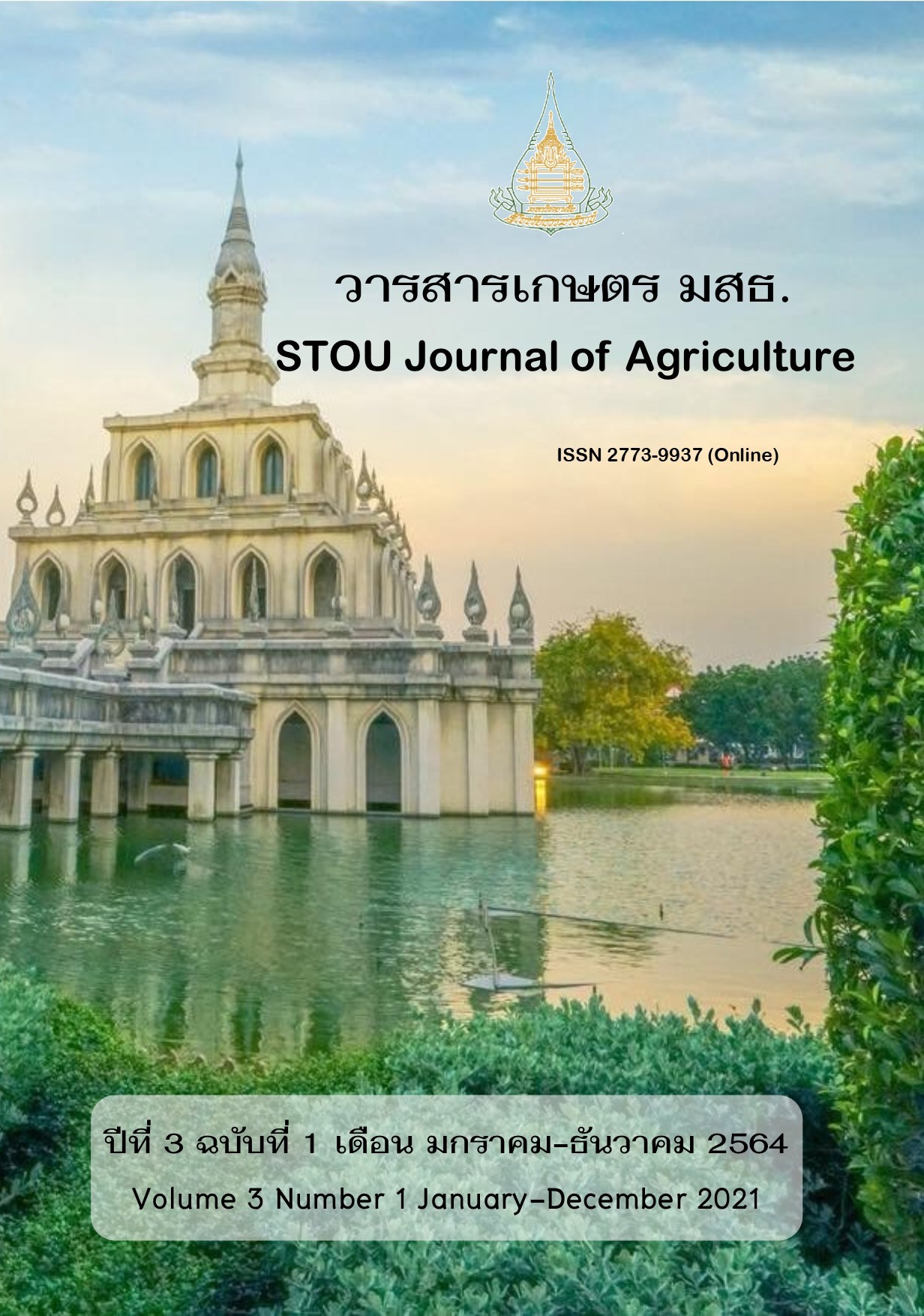Supply Chain Characteristics of Certified Organic Rice in Yasothon Province, Thailand
Main Article Content
บทคัดย่อ
The objectives of this study were to investigate supply chain characteristics to sustain the production system of certified organic rice producing farms in Yasothon province, Thailand to the export market. The sample group consisting of 328 farmers practicing organic rice farming were selected by the purposive sampling technique. The data were collected through a field survey, interviewing representatives of main actors in the supply chain such as the leader of an organic rice growing farm from 11 groups, the collector/processor, and 3 of the exporters. The data was collected from group discussions with the deputy governor, standard auditor (ACT), and members of the farmer group and then analyzed. The farmer sage was used as a tool for establishing strategic plans, suggesting guidelines for developing organic agricultural producer strategies in the supply chain of Yasothon province, Thailand. The results showed that the characteristics of the organic rice supply chain in Yasothon were shorter than conventional rice. However, the data revealed that the current situation of the supply chain in the focused area predicted the highest 70% of the total produce annual export of organic rice to United States of America, Singapore, and European markets apart from the domestic market which constitutes 30% of the total produce. Besides, the Yasothon model has two important components which are 1) strong original capital 2) join forces with the driving force forward.
Article Details
บทความที่ได้รับการตีพิมพ์เป็นลิขสิทธฺ์ของวารสารเกษตร มสธ.
ข้อความที่ปรากฎใน
เอกสารอ้างอิง
Ajibefun, I. A. & Daramola, A. G. (2003). Determinants of technical and allocative efficiency of micro-enterprises: firm-level evidence from Nigeria. New Jersey. USA. : African Development Bank, pp. 353-395.
Chang, M.W., & Schster, E.W. (2018). Understanding the organic foods supply chain: Challenges and opportunities from farm gate to end consumer. Retrieved on May 10, 2019 from http://web.mit.edu/edmund_w/ www/ Agribusiness,%206-7-02.pdf
Department of Foreign Trade. (2019). Measures Related to Imports and Exports. Retrieved on May 8, 2019 from http://www.dft.go.th/en-us/
Edwardson, W., & Santacoloma, P. (2013). Organic supply chains for small farmer income generation in developing countries case studies in India, Thailand, Brazil, Hungary and Africa. Rome: Food and Agriculture Organization of the United Nation.
Elhendy, A. M., & Alkahtani, S. H. (2013). The resource use efficiency of conventional and organic date farms in Saudi Arabia: A data envelopment analysis approach. J. Anim. Plant Sci., 23(2), 596-602.
ICEM. (2003). Thailand national report on protected areas and development. Retrieved on May 13, 2019 from http:// http://www.mekong-protected-areas.org/thailand/docs/thailand_nr.pdf.
Kerdsriseam, C., & Suwanmaneepong, S. (2015). Organic agricultural producer strategies in supply chain of sustainable agriculture network, Chachoengsao Province, Thailand. Journal of Agricultural Technology, 11(8): 1731-1742.
Kerdsriserm, C., Suwanmaneepong, S. & Mankeb, P. (2018). Comparative analysis of the technical efficiency of different production systems for rice farming in Eastern Thailand. Asian J. Sci. Res., 11(4): 480-488.
Kottila, M.R., Maijala A., & Rönni, P. (2006). The organic food supply chain in relation to information management and the interaction between actors. Retrieved on May 10, 2019 from http://www. orgprints.org/5952/1/Kottila.pdf.
Lertsukkasem, B. (2018). Organic agriculture, Yasothon Way. The story and experience of driving the organic agriculture vision of Yasothon Province. The prototype organic city of Thailand. Bangkok: AkkhaThai, Thailand.
Mazzawi, R., & Alawamleh, Mohammad. (2013). The impact of supply chain performance drivers and value chain on companies: a case study from the food industry in Jordan. Int. J. Netw. Virtual Organ, 12(2): 122-132.
Mia, M.A.H., & Islam, M.A. (2014). Critical success factors for ensuring efficient supply chain management (SCM): A review of literature. Bangladesh j. MIS, 7(1): 17-32.
Muthayya, S., Sugimoto, J. D., Montgomery, S., & Maberly, G. F. (2014). An overview of global rice production, supply, trade, and consumption. Ann. N. Y. Acad. Sci., 1324(1), 7-14.
Office of Agricultural Economics. (2000). Poverty incidence of southern agricultural household in crop year 1998/1999. Bangkok, Thailand: Office of Agricultural Economics.
Office of Agricultural Economics. (2010). Fundamental data on agricultural economics for the year 2009. agricultural statistics No. 414. Bangkok, Thailand: Office of Agricultural Economics.
Olugu, E.U., & Wong, K.Y. (2009). Supply chain performance evaluation: Trends and challenges. Am. J. Appl. Sci., 2(1): 202-211.
Pochatan, S. (2005). Technical efficiency of rice production in Thailand. (Doctoral dissertation). Ramkhamhaeng University. Thailand.
Ruenglertpanyakul, V. (2018). Organic Thailand, 2016. Retrieved on Mach 20, 2019 from http://www.greennet. or.th/article/411.
Sharma, V., Giri, S., & Rai, S.S. (2013). Supply chain management of rice in India: a rice processing company’s perspective. IJMVSC, 4(1): 25-36.
Songsrirod, N. (2007). Technical efficiency and the determinants of technical inefficiency on conventional and certified organic Jasmine Rice farms in Yasothon Province. (Doctoral dissertation). Kasetsart University. Thailand.
Taotawin, N. (2011). Environmental change and agricultural sustainability in the Mekong Delta, Advances in Global Change Research 45, Retrieved on May 8, 2019 from DOI 10.1007/978-94-007-0934-8_23.
Thailand map. (2019, Mach 20). Retrieved on Mach 20, 2019 from http://google.com.
Thanawong, K., Perret, S. R., & Means, C. B. (2014). Eco-efficiency of paddy rice production in Northeastern Thailand: a comparison of rain-fed and irrigated cropping systems. J. Clean. Prod., 73: 204-217.
Thuithaisong, C., Parkpian, P., Shipin, O. V., Shrestha, R. P., Naklang, K., DeLaune, R. D., & Jugsujinda, A. (2011). Soil-quality indicators for predicting sustainable organic rice production. Commun Soil Sci Plant Anal., 42(5): 548-568.
Van Nguyen, N., & Ferrero, A. (2006). Meeting the challenges of global rice production. Paddy Water Environ., 4:1–9.
Yasothon Provincial Office. (2018, May 10). Retrieved on May 10, 2019 from http://www.yasothon.go.th/
Yotkaew, P. (2017). Development of organic rice marketing in Thai social. JMPS, Special Issue. 5(1): 406-420. Retrieved on May 20, 2019 from https://doi.org/10.14457/sdu.res.2017.25.


